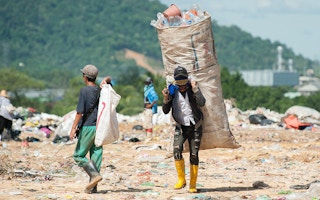Sustainability targets include key performance metrics such as decreasing the use of virgin and single use plastics. To meet these demands regulation is a key driver, but sustainable market development for recycled plastics in Asia also requires greater focus on infrastructure for feedstocks and capacities, technological developments to meet market needs and resilience in the chain, especially at times of volatility.
To continue reading, subscribe to Eco‑Business.
There's something for everyone. We offer a range of subscription plans.
- Access our stories and receive our Insights Weekly newsletter with the free EB Member plan.
- Unlock unlimited access to our content and archive with EB Circle.
- Publish your content with EB Premium.
Driven by end user requirements, the Ellen MacArthur Global Commitment, in collaboration with the UN Environment Program, includes signatories from over 500 organisations that have agreed plastic waste reduction targets.
Key performance metrics include ensuring 100 per cent of plastic packaging is reusable, recyclable or compostable as well as ensuring increased use of recycled content and decreased use of virgin plastic in packaging.
The voluntary initiative further comprises lowering the use of single use plastics and eliminating problematic or unnecessary plastic packaging. With organisations involved representing the use of over 20 per cent of total packaging used globally, this commitment has driven demand for recycled polymers.
But what is the status of plastics recycling in Asia, how is it progressing, and what does the regulatory landscape look like?
Current state of the Asia’s plastics recycling capabilities
There is a growing demand for recycled feedstock in Asia with huge fibre industries in India and China and, apart from extreme market conditions in 2023, a consistent demand, especially for PET. Growth in plastic recycling capacities is building in the APAC region.
In 2022, the Asia Pacific region had the capacity to mechanically recycle PE, PP and PET waste to produce over 18 million tonnes of recycled polymer, increased from around 9 million tonnes in 2012, with the vast majority of market share in China.
Chemical recycling in Asia is currently building capacity with plans in place to scale this over the coming years, with announced projects including those from SKGC, LG Chem, and Lotte Chemicals. However, there is still a need to step up efforts in growing capabilities to meet demands.
Plastic waste collection
While the capability to recycle plastics is crucial, it is dependent on the development of the collection and support infrastructure within the region. Nine out of the top 20 countries for mismanaged waste collection sit within the Asia Pacific region. Those same nine countries are among the top 10 for contributing to marine plastic pollution through rivers, leaking 844,000 tonnes of plastic waste per annum, or 40 times the capacity of a typical R-PET plant, with the Philippines topping the polluters table at over 250,000 tonnes per year.
The informal sector is responsible for the majority of collection in Asia Pacific, specifically in Southeast Asia and the Indian Subcontinent. This sector consists of people with no formal education, skills or of lower social classes who depend on waste collection for a living. Formal waste collection exists in the region as well, but the level of development and extent of coverage varies across the region.
In Southeast Asia, for example, waste collection infrastructure is often inefficient and collection coverage exists for most urban areas only, leaving rural areas with no other options for waste disposal besides open dumping and burning. Therefore, the development of waste collection is essential to complement existing informal waste collection to drive up plastics recycling in the region.
Regulations
The growth in plastic waste and regulatory activities in the region has been strong in recent years despite being a fragmented market with the lack of a regional authority regulating the standards around recycling plastics, such as US-FDA and EFSA focusing on food contact regulations.
In 2022, Thailand published legislation relating to food contact plastics and, in 2023, South Korea approved the use of mechanically recycled polyethylene terephthalate (R-PET) for food and beverage containers. Also in 2022, the Taiwan Food and Drug Administration (TFDA) further announced an application process for the use of R-PET chips and flakes in food containers and packaging manufacturing.
While these policies create a positive environment for plastics recycling, it is important to keep in mind that the effectiveness of these policies depends on many factors including the size of the markets.
One of the biggest influencing factors in Asia is the introduction of Extended Producer Responsibility (EPR). India’s producers, importers and brand owners will be required to meet EPR obligations from 2024/2025 and the Philippines approved a bill to institutionalise EPR on plastic products at the start of 2022, with a target of 80 per cent recovery of plastic products by the end of 2027.
In other countries, Vietnam has proposed mandatory product recycling regulations, with the onus on packaging producers to meet recycling obligations or make financial contribution towards the Vietnam Environmental Protection Fund, and Malaysia has established its first EPR association that wants to reach a minimum recycling rate of 25 per cent of packaging volumes by 2025.
Above and beyond national regulations, major producers are also taking their own initiatives to create a circular plastic economy in Asia. These include Coca-Cola, which is working in India with United Nations Development Programme (UNDP) to create end-to-end plastic waste management, and Unilever, which is working with 4,000 waste banks in Indonesia for the collection, sorting and return of plastic packaging.
Recognising the importance of informal waste collection to local economies, Unilever is also working with the Circulate Capital Ocean Fund and UNDP to protect the livelihood of workers in the informal waste collection sector in India.
Next steps
Investment in recycling capacity in Asia has expanded out of the shift in the agenda for plastics circularity, but this will, and needs to, continue to grow. Reducing the use of single use plastics and consumption of virgin polymers, as well as increasing the lifespan of products will all help towards plastics circularity.
The industry is already seeing announcements around new projects in the region, many of which reflect the increased collaboration across the industry. Waste collection and sorting for recycling will be crucial to reduce plastic waste reaching river and ocean systems, but, while the implementation of formal waste collection facilities will be imperative, these need to be complimentary to the informal waste collection which supports local communities.
Collaboration is increasing throughout the plastics supply chain, which will help bring solutions for improved plastics circularity. To ensure the industry stays on the right path, however, data has a key role to play in developing understanding of current and progressing systems and regulations. ICIS is working with the industry to provide this data and give the insights needed to achieve a plastics circular economy; something which will help the region and the whole world for the future.
Joshua Tan is a plastics recycling analyst at ICIS.











